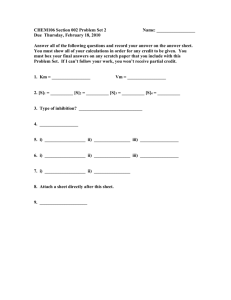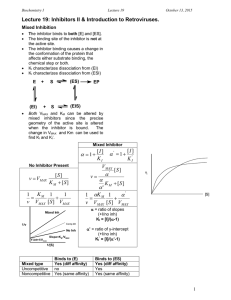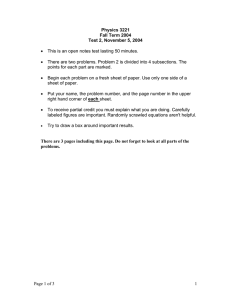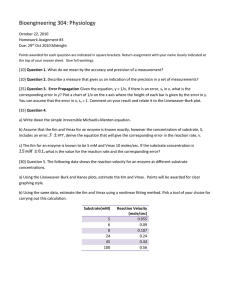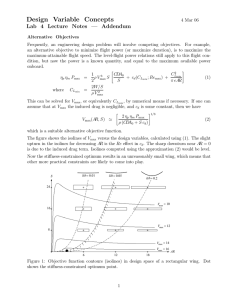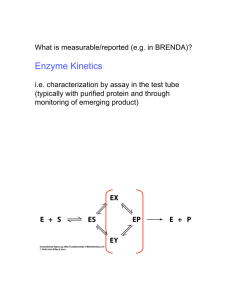Document 15549582
advertisement
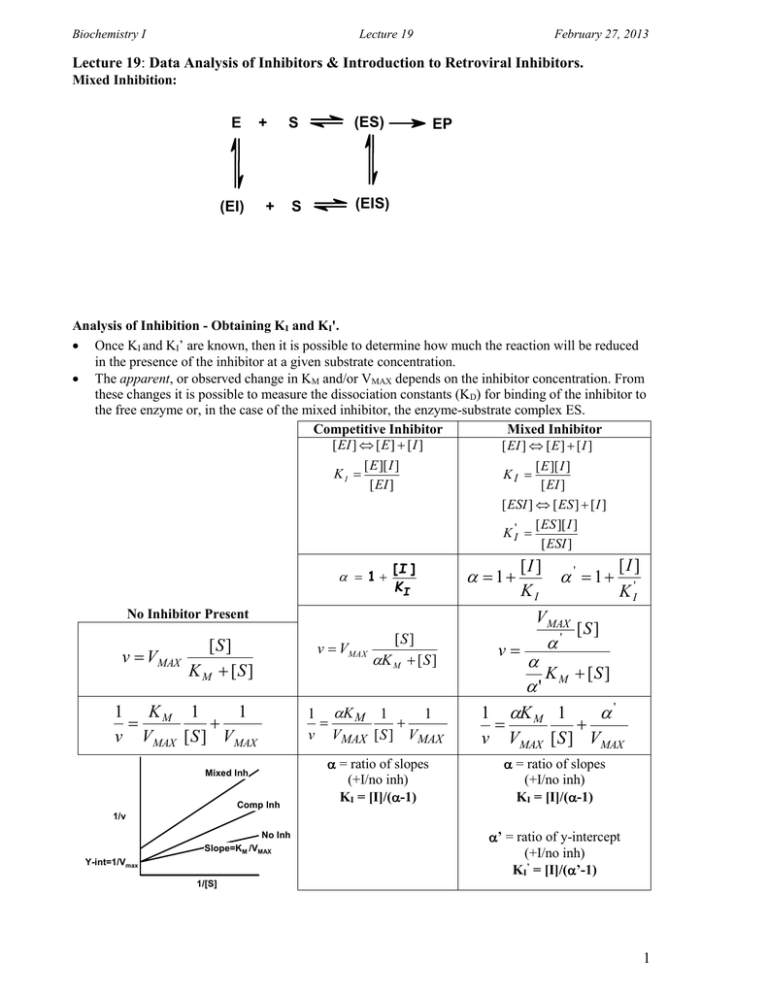
Biochemistry I Lecture 19 February 27, 2013 Lecture 19: Data Analysis of Inhibitors & Introduction to Retroviral Inhibitors. Mixed Inhibition: E (EI) + S (ES) S (EIS) + EP Analysis of Inhibition - Obtaining KI and KI'. Once KI and KI’ are known, then it is possible to determine how much the reaction will be reduced in the presence of the inhibitor at a given substrate concentration. The apparent, or observed change in KM and/or VMAX depends on the inhibitor concentration. From these changes it is possible to measure the dissociation constants (KD) for binding of the inhibitor to the free enzyme or, in the case of the mixed inhibitor, the enzyme-substrate complex ES. Competitive Inhibitor Mixed Inhibitor [ EI ] [ E ] [ I ] [ EI ] [ E ] [ I ] [ E ][ I ] [ E ][ I ] KI KI [ EI ] [ EI ] [ ESI ] [ ES ] [ I ] [ ES ][ I ] K I' [ ESI ] 1 [I ] KI 1 No Inhibitor Present v VMAX [S ] K M [S ] 1 KM 1 1 v VMAX [ S ] VMAX Mixed Inh Comp Inh [I ] KI ' 1 VMAX v VMAX [S ] K M [ S ] v ' [I ] K I' [S ] 1 K M 1 1 v VMAX [ S ] VMAX K M [S ] ' 1 K M 1 ' v VMAX [ S ] VMAX = ratio of slopes (+I/no inh) KI = [I]/(-1) = ratio of slopes (+I/no inh) KI = [I]/(-1) 1/v No Inh Slope=KM /VMAX Y-int=1/Vmax ’ = ratio of y-intercept (+I/no inh) KI’ = [I]/(’-1) 1/[S] 1 Biochemistry I Lecture 19 No Inhibitor Present Competitive Inhibitor KM 1 1 1 v VMAX [S ] VMAX KM 1 1 1 v VMAX [S ] VMAX Obtaining KI (competitive) and KI and KI' (Mixed): Mixed Inhibitor KM 1 1 ' v VMAX [S ] VMAX 0.4 0.3 y = 0.3x + 0.04 1/V The values of and ' can be easily found from the slope and intercept of double reciprocal plots. The six easy steps are: 1. Obtain v versus [S] in the absence of inhibitor. 2. Obtain v versus [S] in the presence of a fixed and known concentration of inhibitor. 3. Plot both data sets on a double reciprocal plot 4. = ratio of the slopes. 5. ' = ratio of Y-intercepts. [I ] [I ] 6. KI and KI' ('1) ( 1) February 27, 2013 0.2 y = 0.1x + 0.01 0.1 y = 0.05x + 0.01 0 0 Example: 0.1 0.2 0.3 0.4 0.5 0.6 0.7 0.8 0.9 1 1/[S] [S] mM 1 5 10 20 v v v ([I]=0) 16.7 50.0 66.7 80.0 IA 9.1 33.3 50.0 66.7 IB 2.9 10.0 14.3 18.2 [I]=10 M. for both inhibitors. Inhibitor A: Obtain : Slope [I=0]: 1/S 1/V 1/V 1/V 1.0 0.2 0.1 0.05 ([I]=0) 0.060 0.020 0.015 0.0125 IA 0.110 0.030 0.020 0.015 IB 0.340 0.100 0.070 0.055 Inhibitor B: Obtain : Slope [I=0]: Slope [IA]: Slope [IB]: =slope([IA]>0)/slope([I]=0): =slope([IB]>0)/slope([I]=0): KI: KI: Obtain '= y-int([IB]>0)/y-int([I]=0): K’I: 2 Biochemistry I Lecture 19 February 27, 2013 Retroviral inhibitors - Human Immunodeficiency Virus (HIV) The normal flow of information in cells is: DNA → mRNA → protein In retroviruses, the genetic information is stored in RNA (vRNA) which must be first be copied into DNA. The flow of information in retroviruses is: vRNA → DNA → mRNA → protein → vRNA Central Role of T-helper (TH) Cells in Immunity: Activate B-cells so that they can differentiate into plasma cells → secrete antibodies that inactivate pathogens (bacteria, viruses). Infection of the TH cells by HIV results in loss of TH cells. HIV infected individuals cannot make antibodies against relatively harmless pathogens. HIV Viral Infection of T-Helper Cells: 1. Viruses bind to molecules displayed on the TH cell surface. 2. The virus then fuses with the cell membrane and releases its RNA genome from its lipid envelope. 3. The enzyme reverse transcriptase first makes a double-stranded DNA copy of the viral RNA molecule. This process is error prone, leading to mutations in the virus. These mutations cause drug resistant strains of the virus to arise. 4. The DNA is integrated into the host cell’s DNA by an enzyme called integrase. 5. Viral RNA for new viruses is made from integrated viral DNA. 6. Viral proteins are also made from vRNA. 7. HIV protease required for maturation of viral proteins and the production of new viruses. The virus particle contains, in addition to vRNA, reverse transcriptase, integrase, and HIV protease. Potential Drug Targets: 3
